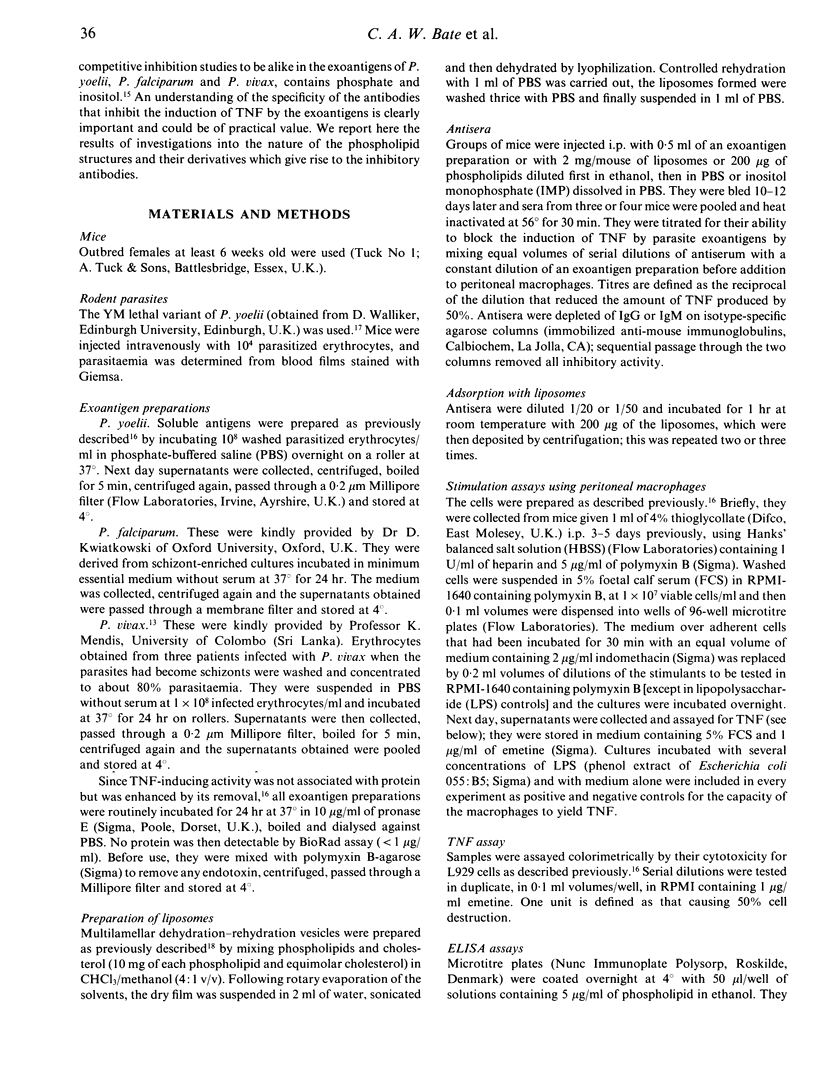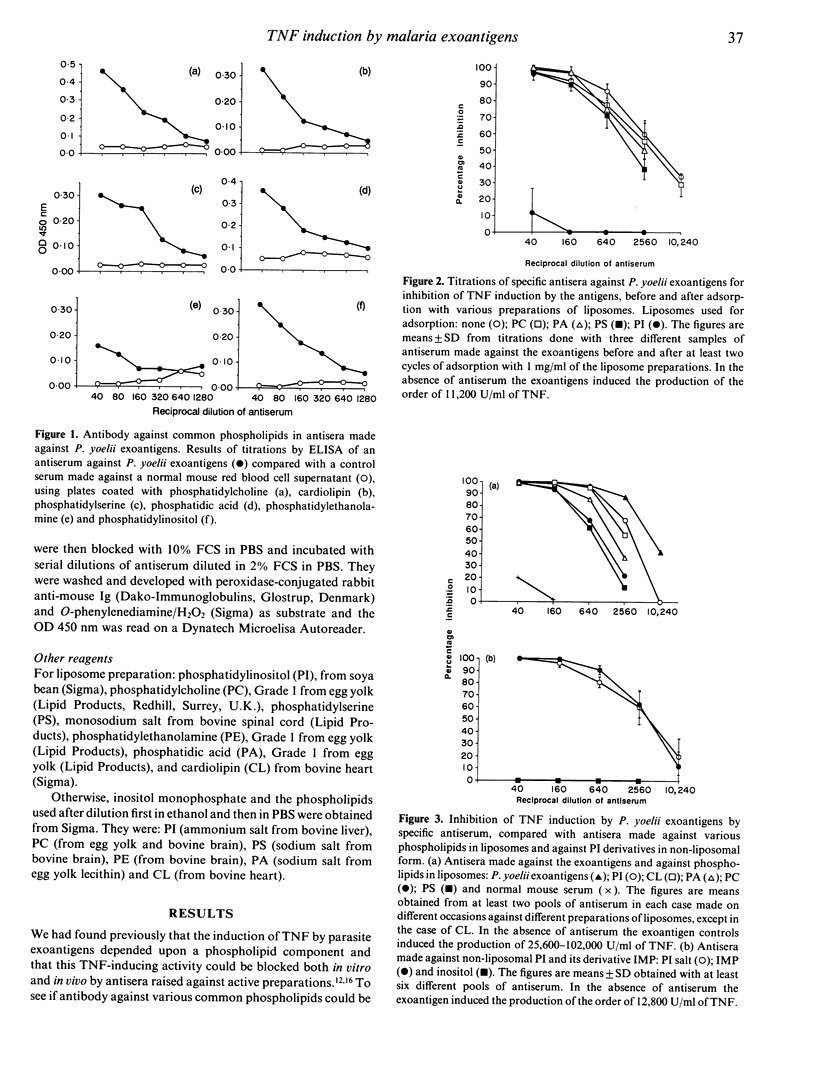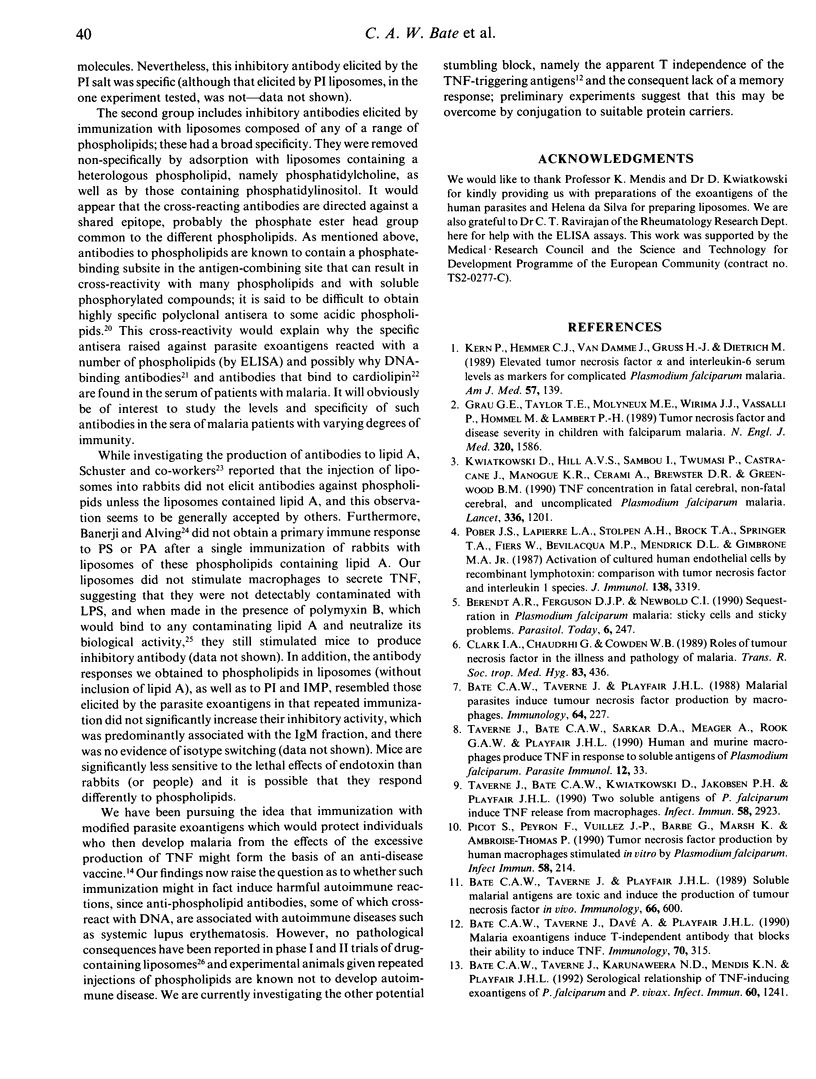Abstract
The active component of the exoantigens of malarial parasites which stimulates macrophages to secrete tumour necrosis factor (TNF) has been shown to depend upon a phospholipid, the activity of which was blocked by phosphatidylinositol (PI) and inositol monophosphate (IMP) in competitive inhibition studies. Antisera made against the exoantigens of Plasmodium yoelii, which inhibited their induction of TNF, were found by an ELISA assay to contain antibody against several other phospholipids. However, the inhibitory antibody was removed specifically by adsorption with liposomes containing PI, but not other phospholipids. Furthermore, PI was the only phospholipid in non-liposomal form which induced the production of inhibitory antisera. Mice immunized with IMP, but not inositol, also produced inhibitory antisera. When incorporated into liposomes several other phospholipids did give rise to inhibitory antibodies but, in contrast to the antisera against parasite exoantigens, PI and IMP, the inhibitory activity was removed by adsorption with heterologous phospholipid liposomes, suggesting that it was directed against a common determinant, presumably the phosphate ester head group. Inhibitory antibodies in the antisera tested were predominantly IgM and titres were not increased after repeated injections. Antisera raised against PI, IMP or the cross-reacting phospholipid liposomes also inhibited TNF secretion by macrophages stimulated by exoantigens of the human parasites P. falciparum and P. vivax, but not by bacterial lipopolysaccharide. These findings confirm our conclusion that exoantigens from these different species contain phosphate bound to inositol in their TNF-inducing moiety.
Full text
PDF






Selected References
These references are in PubMed. This may not be the complete list of references from this article.
- Alving C. R. Antibodies to liposomes, phospholipids and phosphate esters. Chem Phys Lipids. 1986 Jun-Jul;40(2-4):303–314. doi: 10.1016/0009-3084(86)90075-7. [DOI] [PubMed] [Google Scholar]
- Banerji B., Alving C. R. Antibodies to liposomal phosphatidylserine and phosphatidic acid. Biochem Cell Biol. 1990 Jan;68(1):96–101. doi: 10.1139/o90-012. [DOI] [PubMed] [Google Scholar]
- Bate C. A., Taverne J., Davé A., Playfair J. H. Malaria exoantigens induce T-independent antibody that blocks their ability to induce TNF. Immunology. 1990 Jul;70(3):315–320. [PMC free article] [PubMed] [Google Scholar]
- Bate C. A., Taverne J., Playfair J. H. Malarial parasites induce TNF production by macrophages. Immunology. 1988 Jun;64(2):227–231. [PMC free article] [PubMed] [Google Scholar]
- Bate C. A., Taverne J., Playfair J. H. Soluble malarial antigens are toxic and induce the production of tumour necrosis factor in vivo. Immunology. 1989 Apr;66(4):600–605. [PMC free article] [PubMed] [Google Scholar]
- Bate C. A., Taverne J., Román E., Moreno C., Playfair J. H. Tumour necrosis factor induction by malaria exoantigens depends upon phospholipid. Immunology. 1992 Jan;75(1):129–135. [PMC free article] [PubMed] [Google Scholar]
- Berendt A. R., Ferguson D. J., Newbold C. I. Sequestration in Plasmodium falciparum malaria: sticky cells and sticky problems. Parasitol Today. 1990 Aug;6(8):247–254. doi: 10.1016/0169-4758(90)90184-6. [DOI] [PubMed] [Google Scholar]
- Clark I. A., Chaudhri G., Cowden W. B. Roles of tumour necrosis factor in the illness and pathology of malaria. Trans R Soc Trop Med Hyg. 1989 Jul-Aug;83(4):436–440. doi: 10.1016/0035-9203(89)90240-x. [DOI] [PubMed] [Google Scholar]
- Colaço C. B., Male D. K. Anti-phospholipid antibodies in syphilis and a thrombotic subset of SLE: distinct profiles of epitope specificity. Clin Exp Immunol. 1985 Feb;59(2):449–456. [PMC free article] [PubMed] [Google Scholar]
- Freeman R. R., Holder A. A. Characteristics of the protective response of BALB/c mice immunized with a purified Plasmodium yoelii schizont antigen. Clin Exp Immunol. 1983 Dec;54(3):609–616. [PMC free article] [PubMed] [Google Scholar]
- Friedman R. L., Iglewski B. H., Roerdink F., Alving C. R. Suppression of cytotoxicity of diphtheria toxin by monoclonal antibodies against phosphatidylinositol phosphate. Biophys J. 1982 Jan;37(1):23–24. doi: 10.1016/S0006-3495(82)84580-3. [DOI] [PMC free article] [PubMed] [Google Scholar]
- Grau G. E., Taylor T. E., Molyneux M. E., Wirima J. J., Vassalli P., Hommel M., Lambert P. H. Tumor necrosis factor and disease severity in children with falciparum malaria. N Engl J Med. 1989 Jun 15;320(24):1586–1591. doi: 10.1056/NEJM198906153202404. [DOI] [PubMed] [Google Scholar]
- Gregoriadis G. Immunological adjuvants: a role for liposomes. Immunol Today. 1990 Mar;11(3):89–97. doi: 10.1016/0167-5699(90)90034-7. [DOI] [PubMed] [Google Scholar]
- Kern P., Hemmer C. J., Van Damme J., Gruss H. J., Dietrich M. Elevated tumor necrosis factor alpha and interleukin-6 serum levels as markers for complicated Plasmodium falciparum malaria. Am J Med. 1989 Aug;87(2):139–143. doi: 10.1016/s0002-9343(89)80688-6. [DOI] [PubMed] [Google Scholar]
- Kwiatkowski D., Hill A. V., Sambou I., Twumasi P., Castracane J., Manogue K. R., Cerami A., Brewster D. R., Greenwood B. M. TNF concentration in fatal cerebral, non-fatal cerebral, and uncomplicated Plasmodium falciparum malaria. Lancet. 1990 Nov 17;336(8725):1201–1204. doi: 10.1016/0140-6736(90)92827-5. [DOI] [PubMed] [Google Scholar]
- Morrison D. C., Jacobs D. M. Binding of polymyxin B to the lipid A portion of bacterial lipopolysaccharides. Immunochemistry. 1976 Oct;13(10):813–818. doi: 10.1016/0019-2791(76)90181-6. [DOI] [PubMed] [Google Scholar]
- Picot S., Peyron F., Vuillez J. P., Barbe G., Marsh K., Ambroise-Thomas P. Tumor necrosis factor production by human macrophages stimulated in vitro by Plasmodium falciparum. Infect Immun. 1990 Jan;58(1):214–216. doi: 10.1128/iai.58.1.214-216.1990. [DOI] [PMC free article] [PubMed] [Google Scholar]
- Playfair J. H., Taverne J., Bate C. A., de Souza J. B. The malaria vaccine: anti-parasite or anti-disease? Immunol Today. 1990 Jan;11(1):25–27. doi: 10.1016/0167-5699(90)90007-v. [DOI] [PubMed] [Google Scholar]
- Pober J. S., Lapierre L. A., Stolpen A. H., Brock T. A., Springer T. A., Fiers W., Bevilacqua M. P., Mendrick D. L., Gimbrone M. A., Jr Activation of cultured human endothelial cells by recombinant lymphotoxin: comparison with tumor necrosis factor and interleukin 1 species. J Immunol. 1987 May 15;138(10):3319–3324. [PubMed] [Google Scholar]
- Schuster B. G., Neidig M., Alving B. M., Alving C. R. Production of antibodies against phosphocholine, phosphatidylcholine, sphingomyelin, and lipid A by injection of liposomes containing lipid A. J Immunol. 1979 Mar;122(3):900–905. [PubMed] [Google Scholar]
- Taverne J., Bate C. A., Kwiatkowski D., Jakobsen P. H., Playfair J. H. Two soluble antigens of Plasmodium falciparum induce tumor necrosis factor release from macrophages. Infect Immun. 1990 Sep;58(9):2923–2928. doi: 10.1128/iai.58.9.2923-2928.1990. [DOI] [PMC free article] [PubMed] [Google Scholar]
- Taverne J., Bate C. A., Sarkar D. A., Meager A., Rook G. A., Playfair J. H. Human and murine macrophages produce TNF in response to soluble antigens of Plasmodium falciparum. Parasite Immunol. 1990 Jan;12(1):33–43. doi: 10.1111/j.1365-3024.1990.tb00934.x. [DOI] [PubMed] [Google Scholar]
- Wozencraft A. O., Staines N. A. DNA-binding antibodies and parasitic diseases. Parasitol Today. 1990 Aug;6(8):254–259. doi: 10.1016/0169-4758(90)90185-7. [DOI] [PubMed] [Google Scholar]


